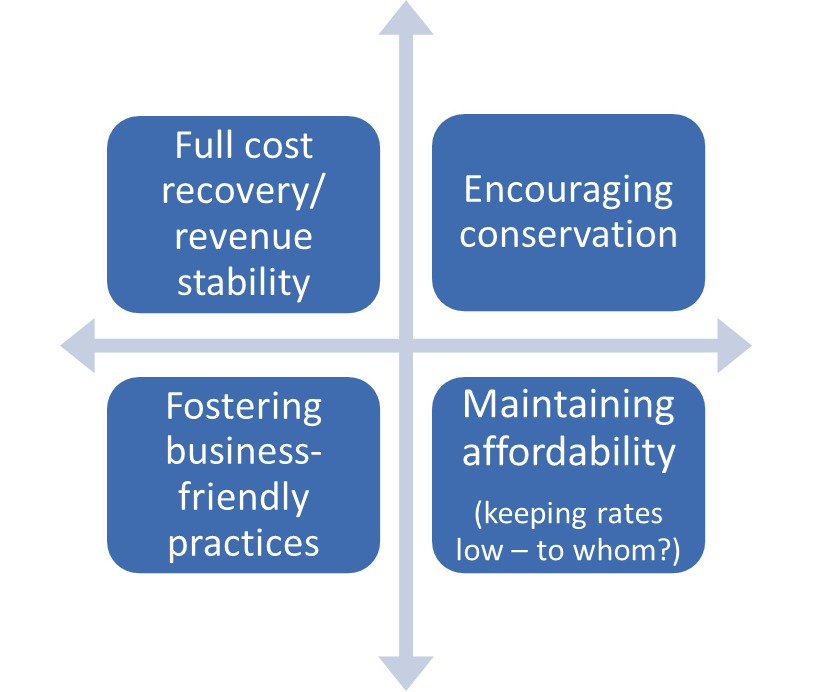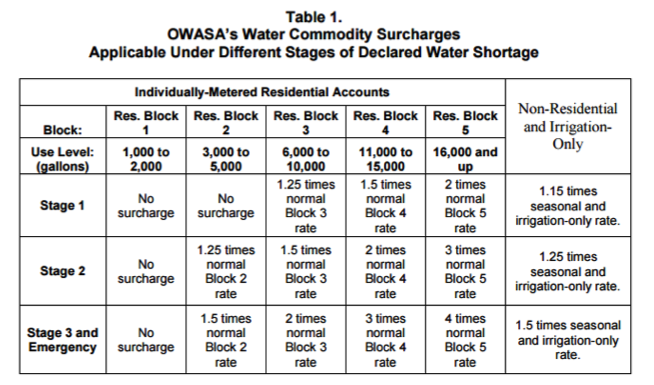At our workshops and through our discussions with water systems during technical assistance work, many water systems, in particular small systems, ask what seems like a simple question: “Are our rates right?”
I suspect our initial answer is somewhat unsatisfying: “It depends.”
Even when rates are sufficient to generate the revenues needed for the utility, whether or not rates are “right” depends on what a particular water system hopes to accomplish with its rate structure. Hopefully, that is more than simply having the lowest rates of any of its neighboring systems. We encourage water systems to articulate a broad range of financial benchmarks for water systems using rate-setting objectives and to rank them from most to least important.

The particular objectives that a water system has will help determine the appropriate rate structure and rate level. With that information in hand, we can then help the system answer its question of whether or not its rates are “right.”
Why Do Water Systems Encourage Conservation?
A common objective that water systems express to us is a desire to encourage conservation amongst its customers. This may be driven by a desire to be good stewards of the environment. Or this may be driven by a system that is near its capacity for treatment and/or storage and is using conservation to delay large capital expenses related to expansion. The system may have a growing customer base and may be in a particularly dry area, something we often hear from systems in New Mexico or Arizona. Or the system may be in an area facing a particularly severe drought, such as the one California is experiencing right now.
Whatever the motivation, water systems that want to promote conservation often target their residential customers’ discretionary water use. Certainly, there is a level of water use necessary to sustain life, and beyond that there is a level that most customers want for basic domestic water uses, including cooking, bathing, and washing. Beyond the basic domestic water uses, residential customers may be using water for additional uses often described as discretionary, including outdoor irrigation, filling swimming pools, washing cars, etc.
There are opportunities to reduce domestic water use through improved technology—low flow fixtures and toilets, water-efficient appliances, etc.—and some water systems will provide financing or rebates to encourage customers to install the technology.
There are additional measures and incentives that water systems employ to encourage customers to reduce their discretionary water use. Some systems enact voluntary or mandatory outdoor watering restrictions. That is the approach California is taking right now due to their drought. California is also offering rebates on fixtures and appliances and even incentives to replace lawn turf with drought-tolerant landscapes.
How can Water Systems Set Rates to Encourage Conservation?
Water systems can also use their rates to create price signals that incentivize conservation, and this ties back to whether or not a system’s rates are “right.” If that system prioritizes the objective of water conservation, then its rate structure should be designed and priced in a way that would significantly increase a customer’s water bill when he or she uses more (discretionary) water and conversely offers a significant decrease in the bill when the customer conserves. There are many ways to design rate structures to provide such incentives for conservation, as listed in this guidance document for water utilities. One example, but certainly not the only one, is to carefully design an increasing block rate structure where the per-thousand gallon (or per ccf) rate significantly rises for higher levels of water use. That way, customers would pay a lower unit price for the necessary and domestic water uses but a higher rate for discretionary water use. Some systems have also started to implement drought surcharges, which automatically raise rates when water supplies dwindle or when certain drought levels are achieved.

In several states, the Environmental Finance Center creates financial sustainability and rates dashboards that are designed to assist utility managers and local officials to compare and analyze water and wastewater rates against multiple characteristics. Many of these dashboards include a comparison dial for “Conservation Signal,” which looks at the difference in the monthly water and/or wastewater bill between 10,000 and 11,000 gallons of water use. Put another way, this is the per-thousand-gallon rate that is set at 10,000 gallons. Although average water use varies across states and even within states, residential customers of an average household size typically much less than 10,000 gallons/month for their necessary and basic domestic water needs. Above 10,000 gallons, residential customers will typically (although not always) be using the extra water for discretionary water uses. The higher a water system sets the rate at that consumption level (and higher), the stronger the conservation price signal it sets for its residential customers. On the dashboards, we display how the water system’s conservation price signal compares to those of other systems in the state, delineating the quartiles of price signals across the state using four different color bands on the dial.
 This financial benchmark, though, has some drawbacks. First, it does not take into account whether the system has a low or high base charge, and there is some evidence that total price, not marginal price, is more likely to affect customer behavior (water systems can also compare their total price at 10,000 gallons or higher on the dashboards). Second, not all residential accounts using 10,000 or more gallons per month have discretionary water use. For example, a large or multi-generational family whose per-capita water use is average may end up using 10,000 gallons or more every month for their basic domestic needs. These customers may be hurt by high marginal rates as it is difficult for them to reduce water use.
This financial benchmark, though, has some drawbacks. First, it does not take into account whether the system has a low or high base charge, and there is some evidence that total price, not marginal price, is more likely to affect customer behavior (water systems can also compare their total price at 10,000 gallons or higher on the dashboards). Second, not all residential accounts using 10,000 or more gallons per month have discretionary water use. For example, a large or multi-generational family whose per-capita water use is average may end up using 10,000 gallons or more every month for their basic domestic needs. These customers may be hurt by high marginal rates as it is difficult for them to reduce water use.
Nevertheless, the conservation price signal on the dashboards is a good place for water systems to start if they value promoting conservation as an objective in their rate setting. It will help answer the question of whether the system’s rates are “right,” at least for that objective.
